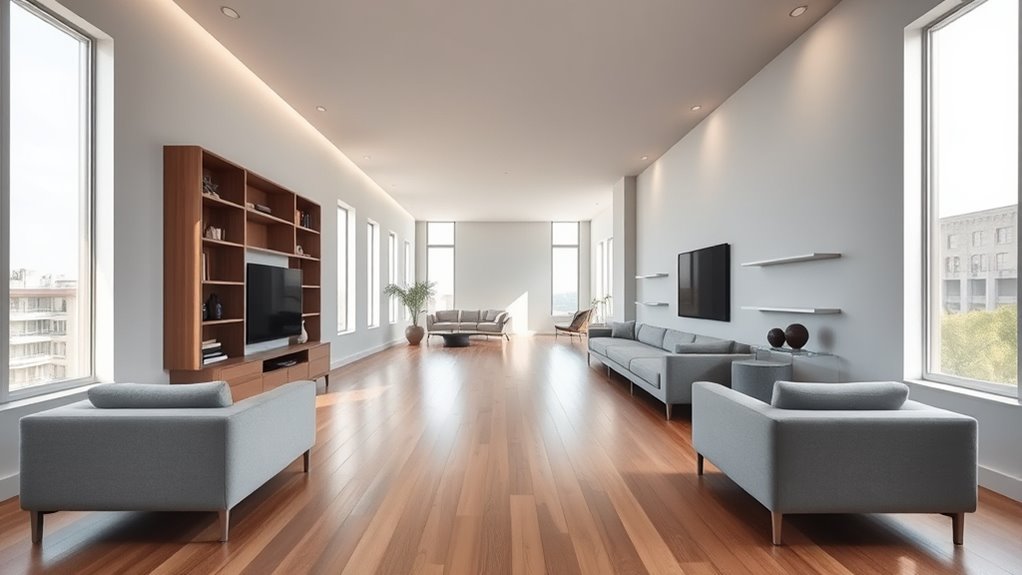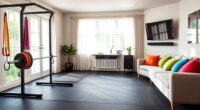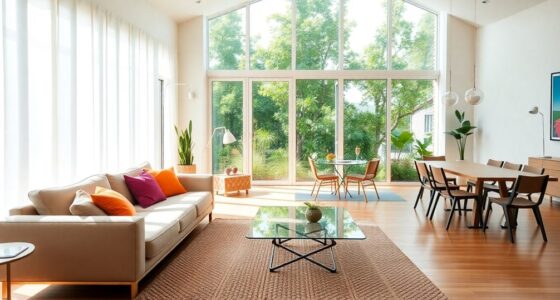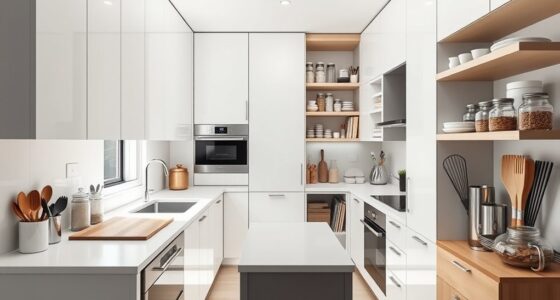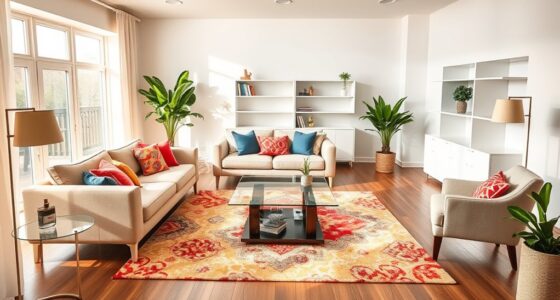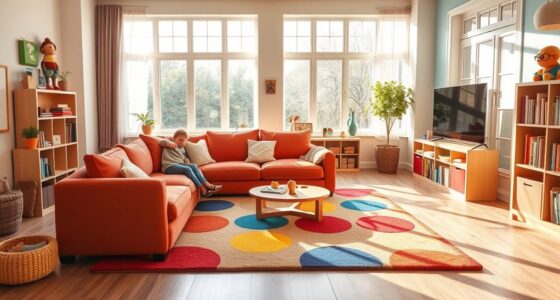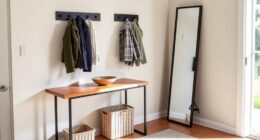To make a long, narrow room feel spacious, focus on strategic lighting, like layered lamps and wall sconces, to brighten and define zones. Arrange furniture to break up the length, using perpendicular placements and multi-functional pieces. Incorporate mirrors to reflect light and create depth, while distinct zones add visual interest. Clever use of decor and intentional furniture placement can transform the space into a cozy, wide-feeling environment—keep exploring for more tips to optimize your room.
Key Takeaways
- Use lighting layers and wall sconces to visually widen the space and create a welcoming atmosphere.
- Arrange furniture perpendicular to the room’s length to define zones and improve flow.
- Incorporate mirrors strategically to reflect light and give an illusion of increased width.
- Employ rugs and decor that break up the room’s length, adding visual interest and depth.
- Maximize utility with multi-functional furniture and floating pieces to enhance space perception and functionality.
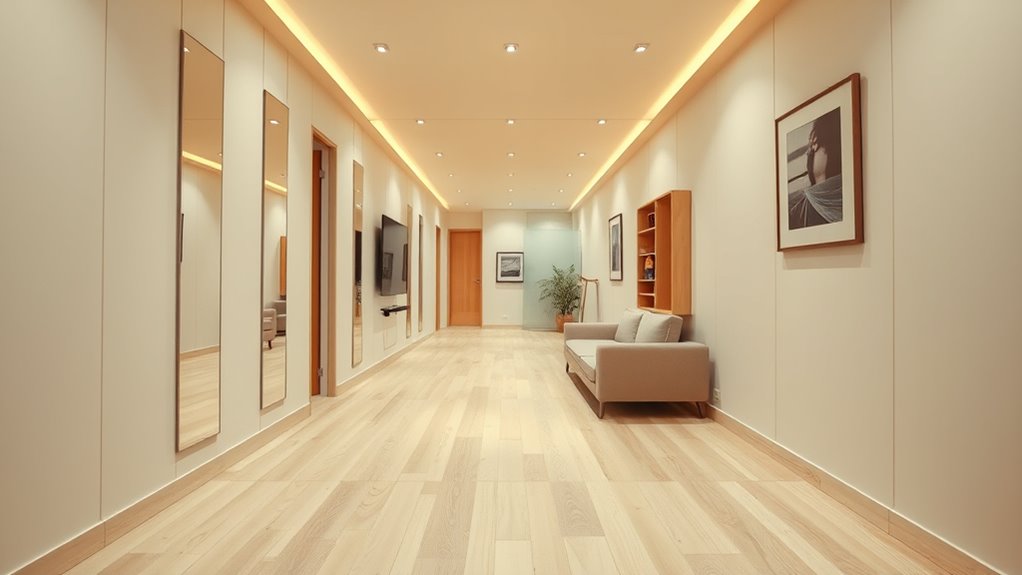
Long and narrow rooms can pose unique design challenges, but with the right approach, they can become functional and visually appealing spaces. The key lies in understanding how to use lighting strategies and furniture arrangements to transform these elongated areas into cozy, inviting environments. The goal is to break up the length and create a sense of balance and flow, making the space feel more open and less cramped.
Transform long, narrow rooms into inviting, balanced spaces with smart lighting and furniture arrangements.
When it comes to lighting strategies, layering is essential. You want to avoid relying on a single overhead light that can cast a harsh, uneven glow and emphasize the room’s narrowness. Instead, incorporate multiple light sources at different levels. Floor lamps and table lamps placed at strategic points can help define zones and add warmth, while wall sconces can provide ambient light without cluttering the space. Consider using track lighting or adjustable fixtures to direct light along the length of the room, highlighting architectural features or artwork, and creating visual interest. Bright, well-placed lighting also helps to extend the perceived width of the room, making it feel larger and more welcoming.
Furniture arrangements play an indispensable role in defining your space and improving its functionality. Instead of lining up furniture along the long walls, opt for arrangements that create a sense of intimacy and break up the expanse. For example, placing a sofa perpendicular to the length of the room can establish a clear seating area without overwhelming the space. Use multi-functional furniture pieces—like ottomans with storage or slim console tables—to maximize utility without cluttering the room. Keep pathways clear by choosing appropriately scaled furniture, and avoid bulky pieces that can make the space feel even narrower. To visually widen the room, consider using rugs that run perpendicular to the length, anchoring the seating area and adding depth. Floating furniture away from walls can also create the illusion of a broader space by introducing more visual interest and fluidity. Additionally, understanding the impact of contrast ratio can help in selecting appropriate lighting and decor that enhance the room’s visual harmony.
In addition, clever zoning helps create distinct areas within a long, narrow room. For example, a reading nook or small workspace can be tucked into one corner, while the main sitting area remains open and inviting. Incorporating mirrors strategically can reflect light and add the illusion of more space, further alleviating the narrow feel. With thoughtful lighting strategies and well-planned furniture arrangements, you can turn a challenging long and narrow room into a stylish, functional retreat that feels balanced and inviting.
Frequently Asked Questions
How Can I Make a Long, Narrow Room Feel More Spacious?
To make a long, narrow room feel more spacious, you should focus on enhancing lighting and adding decorative accents. Use artificial lighting like wall sconces or ceiling fixtures to brighten the space evenly, reducing any claustrophobic feel. Incorporate decorative accents such as mirrors, artwork, or colorful accessories to create visual interest and break up the length. These strategies draw the eye around the room, making it appear larger and more inviting.
What Lighting Options Work Best for Narrow, Elongated Rooms?
You should focus on layered lighting to make your narrow, elongated room feel more open. Use accent lighting to highlight specific features or artwork, drawing attention away from the room’s length. Incorporate a combination of overhead, wall-mounted, and table lamps to create depth and dimension. This layered approach balances brightness, making the space feel larger and more inviting without overwhelming the room’s natural proportions.
Are There Specific Furniture Styles Suited for Narrow Spaces?
They say, “A place for everything, and everything in its place.” For narrow spaces, choose furniture that’s compact and multi-functional, helping you maximize every inch. Opt for slim-profile sofas, vertical storage units, and fold-away tables to keep the room feeling open. These styles allow you to create a practical, stylish environment without cluttering the space, making your narrow room feel more spacious and inviting.
How Can I Create a Balanced Layout in a Long Room?
To create a balanced layout, consider using space division techniques like rugs or furniture arrangements to define zones. Focus on establishing focal points, such as artwork or a fireplace, to draw attention and anchor the room. Keep furniture proportionate to the space, and avoid clutter by choosing multi-functional pieces. This approach helps you maximize flow and visual harmony, making even the longest rooms feel more inviting and well-organized.
What Color Schemes Help to Visually Widen a Narrow Room?
To visually widen a narrow room, you should focus on color schemes that create contrast and openness. Use light, neutral colors on the walls to reflect more light and make the space feel larger. Incorporate an accent wall with a slightly darker shade to add depth without shrinking the room. Avoid heavy or dark colors that can make the space feel cramped, and opt for a cohesive, airy palette.
Conclusion
Just imagine transforming your long, narrow room into a breathtaking corridor of style—so stunning, it feels like stepping into a chic, endless runway. With clever layout tricks, you’ll turn that tight space into a vibrant, dynamic haven that defies its dimensions. Soon, your room won’t just be narrow; it’ll be a masterpiece of design, stretching out like a grand gallery where every inch bursts with personality and purpose. Get ready to conquer those challenging spaces with confidence!
